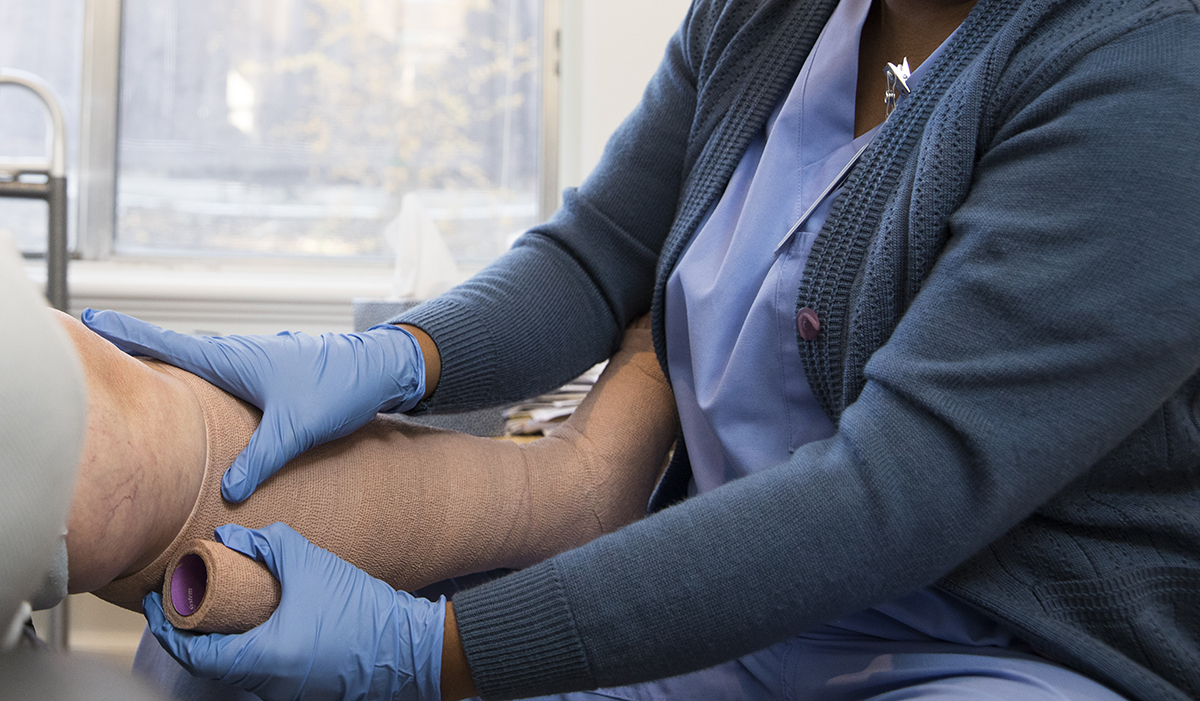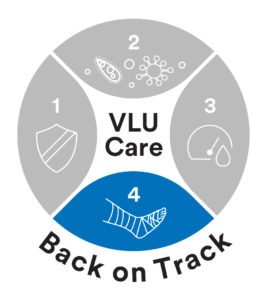
Talking about Compression Therapy for Venous Leg Ulcers with Lynn Peterson, CWOCN Clinical Application Specialist, Wound Care and Compression, 3M Medical Solutions Division
VLUs are a big deal.
Venous Leg Ulcers (VLUs) are the most common type of lower extremity wound, afflicting approximately 1% of the western population during their lifetime.1 VLUs pose significant challenges to patients and healthcare systems because they can persist for months, or even years, have high rates of recurrence, and they’re expensive to manage –- adding up to $14.9 billion2 a year in care costs. Then of course, there’s the ongoing negative impact VLUs have on your patient’s quality of life.
Q: Do you think wound care professionals are aware of the steps in treating VLUs?
A: The principles of VLU management are pretty straightforward: protect skin, manage biofilm, optimize the wound environment and apply compression. However, even wound care specialists dedicated to managing VLUs, aren’t consistent at applying compression. This is documented by an audit of the U.S. wound registry data showing only 17% of outpatient clinic visits documented the implementation of adequate compression.3
Q: Only 17%? Why is the compliance rate so low?
A: That’s right, it is low. Even when most wound care professionals know compression therapy is the “gold standard” in VLU treatment, it’s still surprisingly underutilized for several reasons. Generally, depending on the type of compression, or even past experience, patients just don’t like it. They may complain of it being hot and uncomfortable to wear. Or they may experience slippage and discomfort when wraps loosen and slide down. Then there’s the Unna boot from the 1800’s which is still used today — basically multiple layers of gauze saturated with zinc oxide paste. It’s messy, bulky and can interfere with clothing and shoes. The key is finding a solution that’s well-tolerated by patients. Educating patients on how compression therapy works and why it’s beneficial will also help them be more willing to accept it as part of their treatment plan.
Q: What other factors limit the use of compression therapy?
A: Clinicians can have misconceptions about what “adequate” compression means. They may think that elastic wraps, stockinette or low-level support stockings is enough compression, but it may not be. Clinical studies have shown compression therapy can significantly increase VLU healing rates as compared to no compression, and reduce the likelihood of wound recurrence,1 so proper compression is really important.
Q: Is it possible to apply too much compression?
A: Yes, patients with mixed arterial and venous disease require less or modified compression. For this reason, a thorough patient assessment should be performed to determine the wound etiology and vascular status. An ankle-brachial pressure index, or ABPI*, is a non-invasive screening to ascertain peripheral arterial circulation or more specifically, arterial insufficiency, and is used to determine the level of compression that can be safely applied. Modified or lite compression is indicated for use on patients with an ABPI of 0.5 – 0.8, or patients who are less tolerant of high compression. Compression is contraindicated for patients with an ABPI less than 0.5. Keep in mind, close supervision and patient monitoring is important when using compression on patients with mixed arterial-venous occlusive disease. Follow manufacture instructions for use prior to application. An ABPI should always be performed by a trained specialist.4
* Learn more about how to assess an ABPI here.
https://multimedia.3m.com/mws/media/1082808O/wounds-international-consensus-document.pdf
Q: How can clinicians overcome their hesitation to apply compression therapy?
A: Technique makes a difference. Clinicians with limited experience with compression bandaging application may need additional educational support to learn correct application technique. Correct application includes understanding how much tension to apply during application. For example, a bandage designed to be applied at full stretch, will minimize the potential for application variability. When it comes to learning how to correctly apply compression, I think the preferred method is hands-on training. However, in today’s world of COVID-19 restrictions, some facilities are exploring alternatives to hands-on training.
Q: Are there good alternatives to hands-on training?
A: Yes, there are good on-line application videos that give detailed guidance on how to effectively apply compression therapy. Keep in mind however, not all compression bandage systems are applied the same. It is important to know and follow the product application instructions. Another suggestion is to look into product manufacturers who can present educational webinars on the topic. Also, check with groups such as Home Care agencies or Wound Care facilities where it may be possible to find skilled nurses teaching compression techniques online.
Q: How has COVID-19 disrupted VLU care?
A: Compression therapy is usually done weekly in an outpatient clinic setting. However, many of these clinics limited patient visits or even closed during the first weeks of the pandemic, so many treatments were delayed. Even now that clinics have re-opened, high-risk patients may be unwilling to go back for care, so many clinics are teaming up with Home Care agencies to provide the service. And remember, “home bound” status has changed so more patients qualify for home care services now.
Q: How would you wrap up your message on compression therapy?
A: Start by selecting a product that delivers therapeutic compression, preferably a stiff, inelastic multi-component system that can be modified to fit the patient, be comfortable, look presentable and allow patients to wear their own shoes.
The bottom line is that compression therapy is key to better outcomes. Studies show it can significantly increase VLU healing rates, reduce the risk of recurrence, improve venous return, and reduce edema and inflammation.5,6
We all know that managing VLUs can be challenging work, but the goal of helping more VLU patients heal is within reach.
Resources
For more about the use of compression therapy for VLU patients, download “Consensus Recommendations: Simplifying Venous Leg Ulcer Management,” This consensus document was created by an expert working group, supported by 3M and Wounds International.
1 O’Meara S, Cullum N, Nelson EA, Dumville JC. Compression for venous leg ulcers. Cochrane Database Syst Rev 2012; 11: CD000265.
2 Rice, J. B., Desai, U., Cummings, A. K. G., Birnbaum, H. G., Skornicki, M., & Parsons, N. (2014). Burden of venous leg ulcers in the United States. Journal of medical economics, 17(5), 347-356.)
3 Fife CE, Carter MJ, Walker D. Why is it so hard to do the right thing in wound care? Wound Repair Regen. 2010;18(2):154-8.
4 Harding K. et al. Simplifying venous leg ulcer management. Consensus recommendations. Wounds International 2015
5 O’Donnell TF, et al. J Vasc Surg 2014. Harding K, et al. Consensus recommendations. Wounds International 2015
6 Mosti G, et al. Eur J Vasc Endovasc Surg 2011. Damstra RJ, et al. J Vasc Surg: Venous and Lymphatic Disorders 2014
